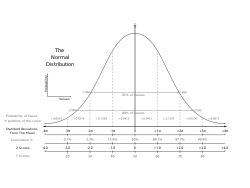Science portal

Science is a systematic discipline that builds and organises knowledge in the form of testable hypotheses and predictions about the universe.[page needed] Modern science is typically divided into two – or three – major branches: the natural sciences, which study the physical world, and the social sciences, which study individuals and societies. While referred to as the formal sciences, the study of logic, mathematics, and theoretical computer science are typically regarded as separate because they rely on deductive reasoning instead of the scientific method as their main methodology. Meanwhile, applied sciences are disciplines that use scientific knowledge for practical purposes, such as engineering and medicine. (Full article...)
Featured article -
Featured pictures
Vital articles

A chemical element is a species of atom defined by its number of protons. The number of protons is called the atomic number of that element. For example, oxygen has an atomic number of 8: each oxygen atom has 8 protons in its nucleus. Atoms of the same element can have different numbers of neutrons in their nuclei, known as isotopes of the element. Atoms of one element can be transformed into atoms of a different element in nuclear reactions, which change an atom's atomic number. Almost all baryonic matter in the universe is composed of elements (among rare exceptions are neutron stars). (Full article...)
Did you know...
- ... that a 1989 science show featured an unusually long signal delay?
- ... that diverse fields study the mind, including psychology, neuroscience, cognitive science, and philosophy?
- ... that a poem by Moses da Rieti includes an encyclopedia of the sciences, a Jewish paradise fantasy, and a post-biblical history of Jewish literature?
- ... that Godwin Obasi has been described as "Africa's gift to the world of climate science"?
- ... that a science fiction short story from 1939 has been called an "eerie prediction" and "an uncanny, horrifyingly vivid prophecy" of The Holocaust?
- ... that physicist Sabine Hossenfelder's book Existential Physics discusses whether free will, the multiverse, the existence of God, and the meaning of life are topics that science can answer?
Get involved
| This portal needs to be updated. Please help update this portal to reflect recent events or newly available information. Relevant discussion may be found on the talk page. |
 |

|
Science News
- 28 October 2025 –
- Nigeria's Senate passes the Endangered Species Conservation and Protection Bill, introducing fines of up to ₦12 million (US$8,250) and prison sentences of up to 10 years for wildlife smuggling and strengthening enforcement against illegal trade in ivory, pangolin scales, and other endangered species. (Reuters)
- 13 October 2025 – Tipping points in the climate system, Environmental issues with coral reefs
- Scientists at the University of Exeter in England report large-scale die-off of coral reefs, the first major tipping point in large changes in the climate system. (The Guardian) (Nature)
- 8 October 2025 – 2025 Nobel Prizes
- Susumu Kitagawa, Richard Robson, and Omar Yaghi are jointly awarded this year's Nobel Prize in Chemistry for their work on metal–organic frameworks. (BBC News)
- 7 October 2025 – 2025 Nobel Prizes, Nobel Prize in Physics
- John Clarke, Michel Devoret, and John M. Martinis are jointly awarded this year's Nobel Prize in Physics for the discovery of macroscopic quantum mechanical tunnelling and energy quantization in an electric circuit. (Euronews)
- 23 September 2025 –
- Scientists in Argentina identify a new megaraptoran species, Joaquinraptor casali, from fossils in Patagonia, providing one of the most complete skeletons of its group. (AP)
- 5 September 2025 –
- A man is killed in a shark attack off Long Reef beach in New South Wales, Australia. The species of shark is currently unknown but it is believed to be a large shark due to the injuries recorded. (The Guardian)
Related portals
Top 10 WikiProject Science Popular articles of the month -
Categories -
![Image 1Structure 12 at Takalik AbajTak'alik Ab'aj (/tɑːkəˈliːk əˈbɑː/; Mayan pronunciation: [takʼaˈlik aˀ'ɓaχ] ⓘ; Spanish: [takaˈlik aˈβax]) is a pre-Columbian archaeological site in Guatemala. It was formerly known as Abaj Takalik; its ancient name may have been Kooja. It is one of several Mesoamerican sites with both Olmec and Maya features. The site flourished in the Preclassic and Classic periods, from the 9th century BC through to at least the 10th century AD, and was an important centre of commerce, trading with Kaminaljuyu and Chocolá. Investigations have revealed that it is one of the largest sites with sculptured monuments on the Pacific coastal plain. Olmec-style sculptures include a possible colossal head, petroglyphs and others. The site has one of the greatest concentrations of Olmec-style sculpture outside of the Gulf of Mexico, and was made a World Heritage Site in 2023 because of its long history of occupation. (Full article...)](http://upload.wikimedia.org/wikipedia/en/d/d2/Blank.png)



























































